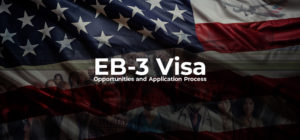
Are you eyeing a new chapter in your career, dreaming of living and working permanently in the United States? The EB 3 visa might just be your ticket to turn those aspirations into reality. Understanding this visa, its pathway to a green card, and the essential requirements can pave the way for your American dream.
EB 3 Visa to Green Card
The EB 3 visa serves as a gateway for professionals and skilled workers aspiring to settle in the U.S. permanently. Unlike its counterparts, the EB1 and EB2 visas, this visa caters to individuals with varying skill levels and qualifications. One of its most attractive features is the EB 3 visa to green card. This is the opportunity it offers to transition from a visa holder to a lawful permanent resident, or green card holder.
To go from EB 3 visa to green card, applicants must navigate through a rigorous process. It starts with securing employment from a U.S.-based company willing to sponsor their visa. Then, the sponsoring employer initiates the process by obtaining a Permanent Labor Certification from the Department of Labor. This certification ensures that there are no qualified American workers available to fill the position.
Navigating EB 3 Visa Requirements: Essential Insights for Applicants
To qualify for this visa, applicants must meet specific eligibility criteria based on their skill level and work experience. The EB 3 visa requirements are divided into three categories: skilled workers, professionals, and unskilled or other workers.
Skilled Workers:
Applicants must have a minimum of two years of work experience or training in a non-temporary or seasonal job role.
Professionals:
This category requires applicants to hold a U.S. baccalaureate degree or its foreign equivalent. Also, applicants need to have a job offer in certain professions such as architecture, engineering, or education.
Unskilled or Other Workers:
Individuals in this category must engage in unskilled labor and possess less than two years of work experience in a non-temporary or seasonal job.
Understanding these distinctions in EB 3 visa requirements is essential for determining eligibility and preparing a strong application.
Streamlining the EB 3 Visa Application Process: Step-by-Step Guide

Navigating the visa application process can seem daunting, but with careful planning and guidance, it can be manageable. Here’s a step-by-step guide to help you through the process:
- Find an EB-3 Sponsor: Begin by securing a job offer from a U.S.-based company willing to sponsor your visa.
- File Form I-140: Once you have a sponsor, file Form I-140, along with the required documents, with the U.S. Citizenship and Immigration Services (USCIS).
- Receive Petition Result: Await the USCIS decision on your petition, which can take several months. Should you opt for premium processing, the visa fees are $2,500 and USCIS will render a decision within a 45-day period.
- Wait for Green Card Availability: After I-140 approval, wait until there are green cards available for your case based on the priority date.
- Adjust Status or Apply at a U.S. Consulate: Once your priority date is current, you can adjust your status if you’re already in the U.S. or apply at a U.S. consulate abroad.
Deciphering EB3 vs EB2: Which Visa is Right for You?

One common question among prospective immigrants is the difference between the EB3 vs EB2 visas. While both visas offer a pathway to permanent residency in the U.S., they target individuals with different skill levels and qualifications.
The EB-2 visa is designed for professionals with advanced degrees or exceptional abilities, making it a preferred choice for individuals with specialized skills or expertise in their field. On the other hand, the EB 3 visa accommodates a broader spectrum of applicants, including skilled workers, professionals, and unskilled laborers.
When deciding between the EB3 vs EB2 visas, it’s essential to assess your qualifications. Also, determine which visa category aligns best with your background and career goals.
Conclusion
The EB 3 visa presents a wealth of opportunities for individuals seeking to establish permanent roots in the United States. From skilled professionals to unskilled workers, this visa caters to a diverse pool of applicants. The pathway from EB 3 visa to green card offers the chance to pursue their American dream.
Understanding the intricacies of the EB 3 visa requirements and the differences between EB3 vs EB2 visas is key to navigating the application process successfully. By partnering with a reputable immigration attorney and staying informed about the latest updates and regulations, you can enhance your chances of securing a visa and embarking on a new chapter of your life in the land of opportunity.




